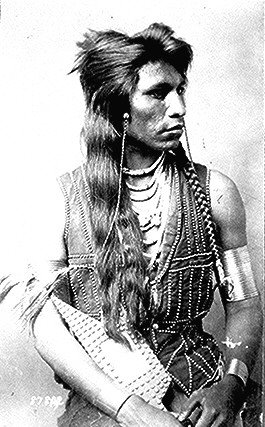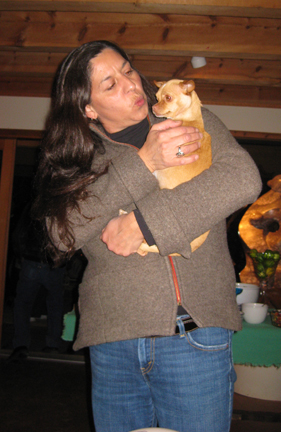|
Orenda
Orenda is the Haudenosaunee name for a certain spiritual energy inherent in people and their environment. It is an "extraordinary invisible power believed by the Iroquois Native Americans to pervade in varying degrees in all animate and inanimate natural objects as a transmissible spiritual energy capable of being exerted according to the will of its possessor." Orenda is a collective power of nature's energies through the living energy of all natural objects: animate and inanimate. Anthropologist J. N. B. Hewitt notes intrinsic similarities between the Haudenosaunee concept of orenda and that of the Siouxan ''wakan'' or ''mahopa''; the Algonquin ''manitowi'', and the ''pokunt'' of the Shoshone. Across the Iroquois tribes, the concept was referred to variously as ''orenna'' or ''karenna'' by the Mohawk, Cayuga, and Oneida; ''urente'' by the Tuscarora, and ''iarenda'' or ''orenda'' by the Huron. Orenda is present in nature: storms are said to possess orenda. A strong con ... [...More Info...] [...Related Items...] OR: [Wikipedia] [Google] [Baidu] |
Mana (Oceanian Mythology)
In Melanesian and Polynesian cultures, ''mana'' is a supernatural force that permeates the universe. Anyone or anything can have ''mana''. They believed it to be a cultivation or possession of energy and power, rather than being a source of power. It is an intentional force. ''Mana'' has been discussed mostly in relation to cultures of Polynesia, but also of Melanesia, notably the Solomon Islands and Vanuatu. In the 19th century, scholars compared ''mana'' to similar concepts such as the '' orenda'' of the Iroquois Indians and theorized that ''mana'' was a universal phenomenon that explained the origin of religions. Etymology The reconstructed Proto-Oceanic word *mana is thought to have referred to "powerful forces of nature such as thunder and storm winds" rather than supernatural power. As the Oceanic-speaking peoples spread eastward, the word started to refer instead to unseen supernatural powers. Polynesian culture ''Mana'' is a foundation of Polynesian theology, ... [...More Info...] [...Related Items...] OR: [Wikipedia] [Google] [Baidu] |
Haudenosaunee
The Iroquois ( ), also known as the Five Nations, and later as the Six Nations from 1722 onwards; alternatively referred to by the Endonym and exonym, endonym Haudenosaunee ( ; ) are an Iroquoian languages, Iroquoian-speaking Confederation#Indigenous confederations in North America, confederacy of Native Americans in the United States, Native Americans and First Nations in Canada, First Nations peoples in northeast North America. They were known by the French during the Colonial history of the United States, colonial years as the Iroquois League, and later as the Iroquois Confederacy, while the English simply called them the "Five Nations". Their country has been called wikt:Iroquoia, Iroquoia and Haudenosauneega in English, and '':fr:Iroquoisie, Iroquoisie'' in French. The peoples of the Iroquois included (from east to west) the Mohawk people, Mohawk, Oneida people, Oneida, Onondaga people, Onondaga, Cayuga people, Cayuga, and Seneca people, Seneca. After 1722, the Iroquoian-sp ... [...More Info...] [...Related Items...] OR: [Wikipedia] [Google] [Baidu] |
Indigenous American Philosophy
Indigenous American philosophy is the philosophy of the Indigenous peoples of the Americas. An Indigenous philosopher is an Indigenous American person who practices philosophy and draws upon the history, culture, language, and traditions of the Indigenous peoples of the Americas. Many different traditions of philosophy exist in the Americas, and have from Precolumbian times. Indigenous-American philosophical thought consists of a wide variety of beliefs and traditions among different American cultures. Among some of U.S. Native American communities, there is a belief in a metaphysical principle called the 'Great Spirit' ( Siouan: '' wakȟáŋ tȟáŋka''; Algonquian: ''gitche manitou''). Another widely shared concept was that of ''orenda'' ('spiritual power'). According to Whiteley (1998), for the Native Americans, "mind is critically informed by transcendental experience (dreams, visions and so on) as well as by reason." The practices to access these transcendental experiences ... [...More Info...] [...Related Items...] OR: [Wikipedia] [Google] [Baidu] |
Sioux
The Sioux or Oceti Sakowin ( ; Dakota/ Lakota: ) are groups of Native American tribes and First Nations people from the Great Plains of North America. The Sioux have two major linguistic divisions: the Dakota and Lakota peoples (translation: referring to the alliances between the bands). Collectively, they are the , or . The term ''Sioux'', an exonym from a French transcription () of the Ojibwe term , can refer to any ethnic group within the Great Sioux Nation or to any of the nation's many language dialects. Before the 17th century, the Santee Dakota (: , also known as the Eastern Dakota) lived around Lake Superior with territories in present-day northern Minnesota and Wisconsin. They gathered wild rice, hunted woodland animals, and used canoes to fish. Wars with the Ojibwe throughout the 18th century pushed the Dakota west into southern Minnesota, where the Western Dakota (Yankton, Yanktonai) and Lakota (Teton) lived. In the 19th century, the Dakota signed land cess ... [...More Info...] [...Related Items...] OR: [Wikipedia] [Google] [Baidu] |
Algonquin People
The Algonquin people are an Indigenous people who now live in Eastern Canada and parts of the United States. They speak the Algonquin language, which is part of the Algonquian language family. Culturally and linguistically, they are closely related to the Odawa, Potawatomi, Ojibwe (including Oji-Cree), Mississaugas, and Nipissing, with whom they form the larger Anicinàpe (Anishinaabeg) group. Algonquins are known by many names, including Omàmiwinini (plural: Omàmiwininiwak, "downstream man/men") and Abitibiwinni (pl.: Abitibiwinnik "men ivinghalfway across the water") or the more generalised name of Anicinàpe. Though known by several names in the past, such as ''Algoumequin'', the most common term "Algonquin" has been suggested to derive from the Maliseet word (): "they are our relatives/allies." The much larger heterogeneous group of Algonquian-speaking peoples, who, according to Brian Conwell, stretch from Virginia to the Rocky Mountains and north to Hudson ... [...More Info...] [...Related Items...] OR: [Wikipedia] [Google] [Baidu] |
Shoshone
The Shoshone or Shoshoni ( or ), also known by the endonym Newe, are an Native Americans in the United States, Indigenous people of the United States with four large cultural/linguistic divisions: * Eastern Shoshone: Wyoming * Northern Shoshone: Southern Idaho * Western Shoshone: California, Nevada, and Northern Utah * Goshute: western Utah, eastern Nevada They traditionally speak the Shoshoni language, part of the Numic languages branch of the large Uto-Aztecan languages, Uto-Aztecan language family. The Shoshone were sometimes called the Snake Indians by neighboring tribes and early American explorers. Their peoples have become members of List of federally recognized tribes, federally recognized tribes throughout their traditional areas of settlement, often co-located with the Northern Paiute people of the Great Basin. Etymology The name "Shoshone" comes from ''Sosoni'', a Shoshoni language, Shoshone word for high-growing grasses. Some neighboring tribes call the Shoshone ... [...More Info...] [...Related Items...] OR: [Wikipedia] [Google] [Baidu] |
Mohawk People
The Mohawk, also known by their own name, (), are an Indigenous peoples of the Americas, Indigenous people of North America and the easternmost nation of the Haudenosaunee, or Iroquois Confederacy (also known as the Five Nations or later the Six Nations). Mohawk are an Iroquoian languages, Iroquoian-speaking people with communities in southeastern Canada and northern New York (state), New York State, primarily around Lake Ontario and the St. Lawrence River. As one of the five original members of the Iroquois Confederacy, the Mohawk are known as the Keepers of the Eastern Door who are the guardians of the confederation against invasions from the east. Today, Mohawk people belong to the Mohawk Council of Akwesasne, Mohawks of the Bay of Quinte First Nation, Mohawks of Kahnawà:ke, Mohawks of Kanesatake, Six Nations of the Grand River, and Saint Regis Mohawk Tribe, a federally recognized tribe in the United States. At the time of European contact, Mohawk people were based in th ... [...More Info...] [...Related Items...] OR: [Wikipedia] [Google] [Baidu] |
Cayuga People
The Cayuga ( Cayuga: Gayogo̱hó꞉nǫʼ, "People of the Great Swamp") are one of the five original constituents of the Haudenosaunee (Iroquois), a confederacy of Native Americans in New York. The Cayuga homeland lies in the Finger Lakes region along Cayuga Lake, between their league neighbors, the Onondaga to the east and the Seneca to the west. Today, Cayuga people belong to the Six Nations of the Grand River First Nation in Ontario, and the federally recognized Cayuga Nation of New York and the Seneca-Cayuga Tribe of Oklahoma. History Political relations between the Cayuga, the British, and the Thirteen Colonies during the American Revolution were complicated and variable, with Cayuga warriors fighting on both sides (as well as abstaining from war entirely). Most of the Iroquois nations allied with the British, in part hoping to end encroachment on their lands by colonists. In 1778, various Iroquois bands, oft allied with British-colonial loyalists ( Tories) cond ... [...More Info...] [...Related Items...] OR: [Wikipedia] [Google] [Baidu] |
Oneida People
The Oneida people ( ; wikt:autonym, autonym: Onʌyoteˀa·ká·, Onyota'a:ka, ''the People of the Upright Stone, or standing stone'', ''Thwahrù·nęʼ'' in Tuscarora language, Tuscarora) are a Native Americans in the United States, Native American tribe and First Nations in Canada, First Nations band government, band. They are one of the five founding nations of the Iroquois, Iroquois Confederacy in the area of upstate New York, particularly near the Great Lakes. Originally the Oneida lived in what is now central New York (state), New York, particularly around Oneida Lake and Oneida County, New York, Oneida County. Today the Oneida have four federally recognized nations: the Oneida Indian Nation in New York, the Oneida Nation in and around Green Bay, Wisconsin, in the United States; and two in Ontario, Canada: Oneida at Six Nations of the Grand River, and Oneida Nation of the Thames in Southwold, Ontario, Southwold. People of the Standing Stone The name Oneida is derived from ... [...More Info...] [...Related Items...] OR: [Wikipedia] [Google] [Baidu] |
Natural Environment
The natural environment or natural world encompasses all life, biotic and abiotic component, abiotic things occurring nature, naturally, meaning in this case not artificiality, artificial. The term is most often applied to Earth or some parts of Earth. This environment encompasses the interaction of all living species, climate, weather and natural resources that affect human survival and economic activity. The concept of the ''natural environment'' can be distinguished as components: * Complete ecological units that function as natural systems without massive civilized human intervention, including all vegetation, microorganisms, soil, rock (geology), rocks, plateaus, mountains, the atmosphere of Earth, atmosphere and list of natural phenomena, natural phenomena that occur within their boundaries and their nature. * Universal natural resources and phenomenon, physical phenomena that lack clear-cut boundaries, such as air, water and climate, as well as energy, radiation, electric ... [...More Info...] [...Related Items...] OR: [Wikipedia] [Google] [Baidu] |
Manitou
Manitou () is the fundamental life force in the theologies of Algonquian peoples. It is said to be omnipresent and manifests everywhere: organisms, the environment, events, etc. ''Aashaa monetoo'' means "good spirit", while ''otshee monetoo'' means "bad spirit". When Turtle Island was created, the Great Spirit, ''Aasha Monetoo'', gave the land to the indigenous peoples. Overview Manitou was widely used during early European contact. In 1585, when Thomas Harriot recorded the first glossary of an Algonquian language, Roanoke (Pamlico), he included the word ''mantóac'', meaning "gods and goddesses". Similar terms are found in nearly all Algonquian languages. In some Algonquian traditions, '' Gitche Manitou'' refers to a supreme being. The term has analogues dating to before European contact, and the word uses of ''gitche'' and ''manitou'' existed before contact. After contact, however, Gitche Manitou was adopted by some Anishinaabe, such as the Ojibwe, to refer to the su ... [...More Info...] [...Related Items...] OR: [Wikipedia] [Google] [Baidu] |





